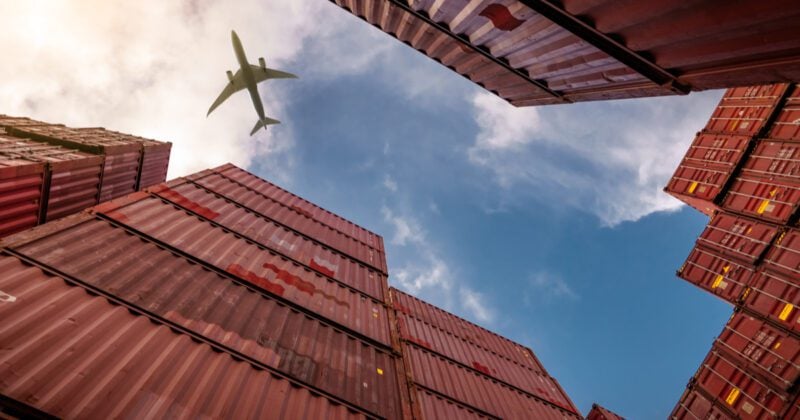航空貨物キャパシティに見える明るい兆し

新型コロナウイルスのオミクロン株が弱まっている中で、より多くの国が渡航禁止を緩和するにつれ、航空貨物のベリー容量はようやく改善の潜在的な兆候を示し始めました。
中国の厳格な封鎖策は、より広範な回復の障害となっていますが、今後数か月のうちに緩和される可能性があります。
DHLの航空貨物概況によると、高いワクチン接種率、冬の終わり、そしてオミクロン株のそれほど深刻ではない性質により、EUや英国では規制を緩和しています。アラブ首長国連邦も旅行の禁止を解除し、フライトを回復する可能性があります。
しかしながら中国での、輸送と航空ネットワークを混乱させる地域封鎖を強制する厳格なゼロコロナ政策は、引き続き航空貨物市場と世界的な製造業を混乱させ続けています。
「中国のコロナ対策は、製造業の生産量と航空貨物輸送のパイプライン全体のキャパシティという点で、リスクを高めています」と、DHLグローバルフォワーディング、アジアパシフィックCEOのケルビン レウンは述べています。「私たちは、そのロジスティクスへの影響を常にモニターしています。そして今後数か月のうちに、これらの政策がある程度緩和されることを期待しています。」
回復する力
他の地域では、兆候はおおむね良好です。IATAでは、2022年1月下旬から2022年2月上旬にかけて、より多くの旅客サービスが戻ってきたため、世界での国際航空券の販売量の11%増加を 記録しました。
1月25日、IATAは、7日間の移動平均を追跡調査し、航空券の販売数が2019年同時期の38%であったと報告しています。しかしながら、2022年2月8日頃、販売チケット数は2019年同時期の販売総数の49%となっています。
IATAは、11ポイントの改善は、危機が始まってからの2週間の期間でもっとも速い増加であると述べています。これは、一部には世界中で国境制限が緩和されはじめていることが要因です。
DHLグローバルフォワーディングの航空貨物グローバル責任者、トーマス マックは次のように述べています。
「これらの要因に加え、世界的に規制が緩和されていることから、近い将来、ベリー容量の回復が期待できます。」
フライトのキャンセルとスローな職場復帰
しかしながら障害は残ります。中国では、当局は引き続き厳格なパンデミック対策を実施しており、その結果主要なハブ空港での貨物の取り扱いとプロセスの生産性が低下しています。
チャイナ・カーゴと中国南方航空は、2月中旬まで合計で31機の米国向けフライトをキャンセルしました。これらは主にチャーター便で、新型コロナの検査キットを輸送する予定でした。香港では、キャセイパシフィックが新しい検疫要件のため、2022年3月末まで、米国および南・西太平洋地区への貨物輸送能力の約80%をキャンセルしました。
新型コロナの拡大と封鎖は、中国の内陸部のロジスティクスと製造業の生産に障害をもたらしています。2022 年2月17日、野村総研は新型コロナの5つの主要なクラスターが発生していることに言及しています。これには、深センや蘇州などの製造エリアが含まれ、封じ込めプロセスの一環として、ハイテク企業が工場を閉鎖したと報告されています。
野村総研はまた、今年は旧正月休暇後の2月17日までに、労働者の58%しか職場に復帰していないことを調査しました。これは、2019年より4.4ポイントも低い値となっています。
より広義に、輸送の正常化に向けた勢いが増加傾向の一方で、旅行市場の上位50のマーケットのうち、中国、日本、ロシア、インドネシア、イタリアなどの経済主要国を含む 13の国では、ワクチン接種済み旅行者であっても入国が容易ではないと述べています。
一息つけるスペース
一方で、旧正月後の貨物需要の一時的な減速により、企業は在庫と売上のバランスに追いつき、より準備できる体制になっています。
これは負担の一部を減らすことに役立ちましたが、貨物が海上貨物から航空貨物に転換し続け、Eコマースの需要が増え続けているため、キャパシティは引き続きしばらくはタイトなままとなります。
キャパシティの初期の回復は、継続的な強い需要にまだ遅れをとっています。EU全域の空港でも、労働力不足が発生しており、倉庫運営に影響を及ぼし、オペレーションの遅延となり、トランジットタイムに更に影響を及ぼしています。
今月と来月には、さらにポジティブな兆候が見られるでしょう。オーストラリアとニュージーランドは国境を再開し、2022年2月21日から、ワクチン接種を受けた人々の国内旅行を許可しています。
エミレーツ、ブリティッシュ航空、エティハド航空、そしてオークランドを拠点とするGo Air Land Sea Logisticsを含む多くの航空キャリアがフライトを再開しており、これにより、全体的な貨物キャパシティが増加します。 エアーニュージーランドは2022年3月に24の国際路線を再開する予定です。
「これらポジティブなマーケットのサインで、2022年下半期の更なる改善がみられることを期待しています」と、レウン氏は述べています。
国境の規制を超えた継続的なチャレンジ
これに直面して、企業は慎重かつ楽観的である必要があり、主要空港で進行中の労働力不足がまだ解決されていないため、状況は常に変化していることを常に念頭に置く必要があります。
「回復の兆しがみられるものの、企業は在庫と需要を、可能な限り先に利用可能なキャパシティと一致させることが不可欠です」と、マック氏は述べています。




 日本語
日本語